Sturm of Vienna
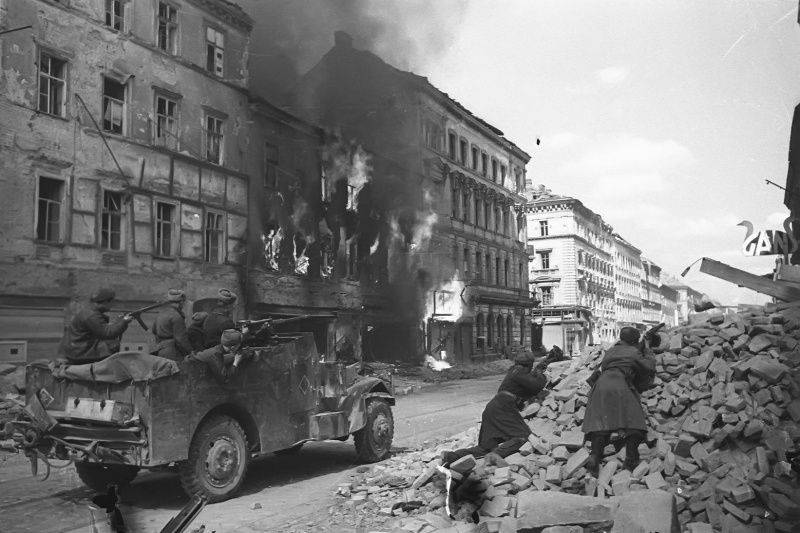
The defeated divisions of the Ami "South" group retreated to Vienna. In order to turn the local population against the Red Army, the German command and the Nazis began to spread rumors that the Russians would destroy all the Austrians - members of the Nazi Party (National Socialist German Workers' Party). The Soviet Headquarters ordered the military councils of the fronts to issue an appeal to the population of Austria. It indicated that the Red Army was fighting with German troops, and not civilians. People were urged not to succumb to panic, remain in their places, continue peaceful work and provide all possible assistance to the Soviet troops and command in maintaining order and continuing normal work of industrial, commercial, utility and other enterprises of Austria. It was pointed out that the Red Army entered Austria only for the purpose of defeating the Wehrmacht, and the country would be restored to the order that existed before the Anschluss 1938 of the year. It was explained that the Nazis were not persecuted polls, and the party would be dissolved without reprisals against ordinary members.
Meanwhile, the German command was trying with all its might to keep Austria. Vienna wanted to turn into the same fortress as Budapest, and for a long time to detain the Red Army in Austria. The time factor remains the last hope of Hitler and his entourage. The military and political leadership of the Third Reich hoped to the last to split the ranks of the anti-Hitler coalition and separate peace with the Western powers. Britain was inclined to such a scenario. However, US President Roosevelt was against the agreement with Hitler or his successors. His premature death (or murder) could not change the situation. April 16 began the Berlin operation, and the beast's lair was destroyed. But if Berlin could have delayed the war for some time, the situation could have been different. No wonder the Anglo-Saxons developed a plan of Operation Unthinkable, which suggested a union of Germany, Britain and the United States directed against the USSR. Churchill was ready to unleash World War III without a pause.
Vienna was to become a strategic fortress of the German Empire. Vienna was of great importance as the political center of Austria, the center of the industrial region, the communications hub that connected Central Europe with Italy and Yugoslavia and as a major port on the Danube. Austria was the last source of oil. Austria was a huge bastion in the German defense system, which covered southern Germany. The loss of Vienna should have led to the further loss of the Wehrmacht’s combat capability and the collapse of the illusions that Germany would be able to withstand the war. The German command appealed to the inhabitants of the city to fight to the last opportunity. However, the Austrians did not feel any desire to fight to the death for the Fuhrer. Some groups of the Austrian Resistance even wanted to raise a rebellion in Vienna as the Red Army approached. However, the idea was disclosed. Hitler ordered to deal with the conspirators "the most severe means." Many plotters were seized and hanged. The Austrian resistance movement was not massive and could not assist the Soviet armies in the liberation of Austria. True, the Austrians were able to provide some information about the defense system of Vienna.
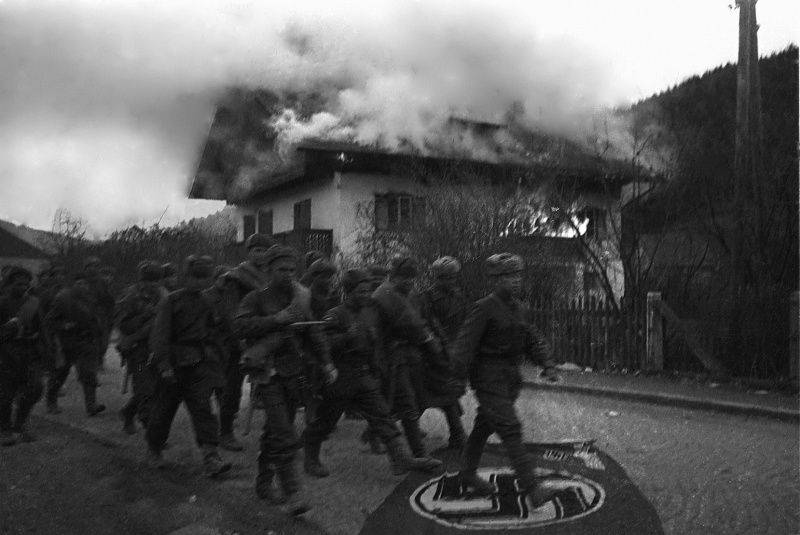
A group of Soviet soldiers walking past a burning Gestapo building near Vienna.
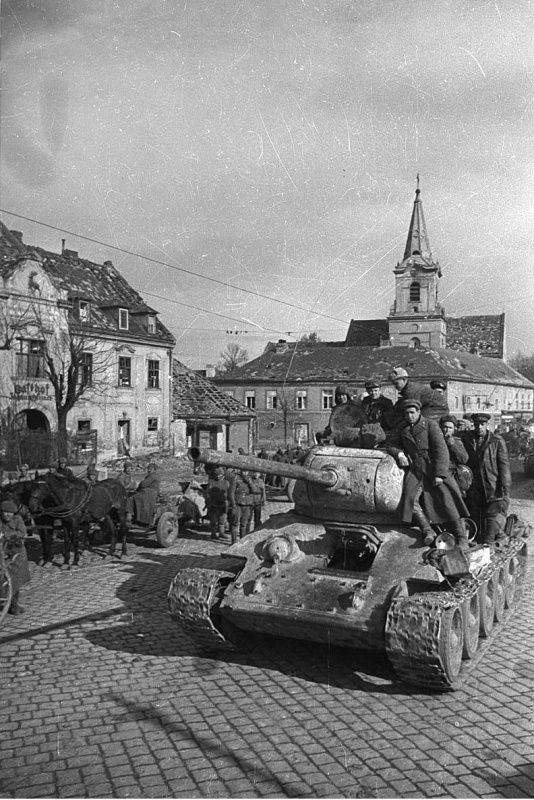
Soviet column tanks T-34 on the streets of Vienna
Sturm of Vienna
The Austrian capital was defended by the SS Z. Dietrich's 6 Panzer Army as part of the 8 Panzer, 1 Infantry Divisions (or rather, their remnants) and up to 15 individual infantry battalions. For the defense of the city, an 4 regiment was formed from the city police. On the approaches to Vienna and in the city itself, the Germans equipped numerous defensive positions. On tank-dangerous directions, anti-tank ditches were prepared on the outer defensive perimeter of the city, erected obstructions and other obstacles, mined bridges and roads. The streets were barricaded. Many buildings have prepared strong points, firing points, which have their own garrisons and are connected with other units in a single combat system. Bridges over the Danube and canals were prepared for destruction.
The task of taking Vienna was to be solved by the 4-I, 9-I Guards, 6-I Guards Tank Army of the 3-th Ukrainian Front and 46-I Army of the 2-Ukrainian Front. 6 On April 1945, the Soviet headquarters ordered Malinovsky to transfer the 46 Army of Petrushevsky, the 23 tank corps of Akhmanov, and the Sviridov Guards mechanized corps to the left bank of the Danube. The troops of the 2 of the Ukrainian Front were to bypass the Austrian capital from the north.
The right wing of the 3 of the Ukrainian Front was to operate south of the Danube, beating Vienna from the southwest. Initially, Tolbukhin planned to deliver three simultaneous strikes at Vienna: the 4-I Guards Army of Zahvatayev with the 1-M Guards Mechanized Corps of Russiyanov came from the southeast; 6-th Kravchenko Guards Tank Army with the 18-Govorunenko Tank Corps and reinforced with infantry of the 9-Guards Army - from the south and south-west; 9-I Gulagolev Guards Army had to bypass the city from the west and intercept the enemy's escape route. However, on the southern and southeastern approaches, the Germans actively defended themselves, going over to counterattacks. Army Zahvatayeva could not achieve quick success. Therefore, the Kravchenko tank army decided to send an 9 Guards Army offensive, where the 38 Guards Rifle Corps could advance 16-18 kilometers. 6-I Guards Tank Army received the task to bypass Vienna and strike at the city from the west and north-west.
The 46th Army of Petrushevsky crossed the Danube in the Bratislava region, and then, crossing the Morava River, moved to Vienna from the northeast. The Danube Military has greatly assisted in the forcing of the Danube flotillawhich in five days transported more than 70 thousand soldiers, 567 guns and much more weapons, equipment, ammunition and military materials. On April 8, the Danube Flotilla landed troops in the Ort area, Mannsdorf (east of the Austrian capital) with a landing force of about one regiment, which helped the rapid advance of the Petrushevsky army to Vienna.
6 April Soviet troops broke into the southern outskirts of Vienna and tied street battles. The commander of 3-th Ukrainian front, Tolbukhin, in order to save the beautiful and ancient city from destruction, addressed the inhabitants of Vienna with a special appeal. Marshal Tolbukhin, on behalf of the Soviet government, urged citizens not to leave Vienna, to prevent the Nazis from mining and destroying buildings, and helping the Red Army. The appeal of the Soviet command was a success. The Austrians not only did not resist, but also helped the Soviet troops in every possible way. In addition, already during the fighting for Vienna, 9 on April 1945, the Soviet government announced that it was not going to seize the Austrian territories or change the socio-political system in the country. Austria had to regain its independence.
April 7 The main forces of the 9-th Guards Army and the 6-th Guards Tank Army formations, breaking through the mountain forest of the Vienna Forest, reached the Danube. As a result, Vienna was surrounded on three sides - east, south and west. The 46 Army of the 2 Ukrainian Front was to complete the encirclement of the Vienna group. However, the German command, in order to avoid the encirclement of the garrison of Vienna, in every way strengthened the northeast direction, by transferring units from the depth of the defense and even Vienna itself. In the city itself, stubborn fighting continued until April 13.
Despite the refusal of citizens to support the Nazis, the battle for the city had a fierce character. Persistent battles were fought for every quarter, street, and often for individual houses, turned into strong points. The fighting went on day and night. In such battles, the main importance were the actions of the assault groups reinforced by tanks and self-propelled guns. The 4 units of the Guards Army stormed Vienna from the east and south, the 9 units of the Guards and 6 Guards Tank armies entered the city from the west. The armies of the Glagolev and Zakhvatiev armies advanced deep into the city and entered into tactical interaction. By the end of April 10, only the center of the city remained in German hands.
The Germans blew up all the bridges in the city, leaving only one - the Imperial Bridge (Reichsbrücke). He was mined, but left to be able to maneuver forces between the western and eastern parts of the city. In the area of the bridge, the Germans created a powerful defense center. The storming of the bridge could lead to its destruction, which made it difficult for the Soviet movement and forced them to force a serious water barrier and capture the bridgehead. Attacks on the 9 and April 10 bridges did not lead to success. Therefore, the Soviet command decided with the help of the ships of the Danube Flotilla to disembark from the Imperial landing and take it with an unexpected strike. The detachment of the Danube Flotilla consisted of three groups: a covering detachment (5 armored boats), a detachment of artillery support ships (8 mine boats) and an amphibious detachment. The rifle company of the 80-th Guards Rifle Division from the 4-th Guards Army — about 100 fighters under the command of Senior Lieutenant Yegen (Gegham) Akopovich Pilosyan.
The operation was unique. Armored boats from the 2nd brigade of river ships under the command of the 2nd-rank captain Alexander Arzhavkin fought to the landing site and, under cover of a smoke curtain, landed paratroopers, who immediately captured the bridge and neutralized the demolition lines. This breakthrough came as a surprise to the Germans, who were struck by the audacity of the Soviet soldiers. After all, the bridge was in the center of the city, where both banks were occupied by German troops, the Germans had a significant number of firing points in stone buildings and reinforced concrete pillboxes, tanks and machine-gun nests. On the way it was necessary to pass the blown up Vienna bridge, and the fairway had many obstacles, including flooded ships. The operation had to be carried out during the day due to numerous obstacles in the river. In close street combat aviation I could not fully support the landing.
The Germans immediately pulled up additional troops to the Imperial Bridge, supported by tanks, self-propelled guns and artillery. The armored boats that supported the landing with fire were forced to leave in order not to die. They simply would have been shot as targets, they could not maneuver. Almost all ships were seriously damaged, among the crew members were dead and wounded, but were able to leave.
The battle for the Imperial Bridge was extremely fierce. One German attack followed another on both sides of the river, the cross-squall fire did not stop for a minute. The Germans attacked even at night, which was unusual for them. Marines fought in the environment for almost three days. A huge role in the fact that they resist, played artillery. The airborne detachment was supported by significant artillery forces — the Coastal Guard Detachment of the Danube Flotilla (5 batteries of large and medium caliber) and a significant number of army artillery. On the night from 12 to 13 in April, a landing battalion from the 7 Guards Airborne Division made its way through the quarters occupied by German troops. However, the Germans not only did not weaken the onslaught, but also strengthened it. The situation was critical, the landing was on the verge of death.
Only in the morning of April 13 there was a break in favor of our troops. A consolidated assault squad from the brigade of marines attached to the Danube Flotilla, breached the enemy defenses in the area of the Vienna bridge. A regiment of the 80-th Guards Rifle Division was entered into the breach, which with great effort was able to make its way to the Imperial Bridge and connected with the landing force. Then the remaining forces of the division, reinforced by self-propelled guns, entered the breakthrough and they also reached the bridge, dismembering the enemy's eastern grouping. This moment was a turning point in the battle for Vienna. Having lost unified management and interaction, support from the western part of the city, the eastern grouping was dismembered and by the end of the day destroyed or surrendered. After that, the Western group began to leave the city. On the night of April 14 Vienna was finally cleared of the Nazis.
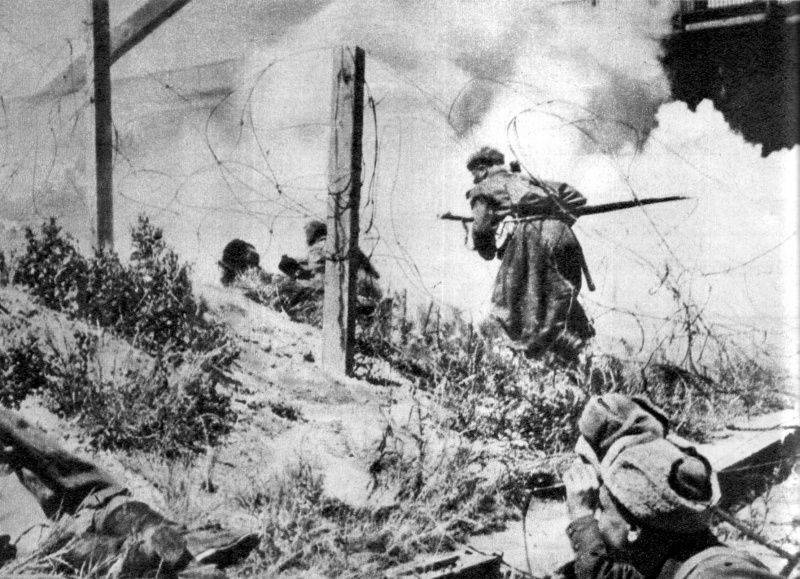
Soviet soldiers fight for the Imperial Bridge in Vienna
In the meantime, the 9 units of the Guards Army reached the Traisen River, in the area of the city of St. Pölten. After that, 9-th Guards Army was taken to the reserve of the front, located in the area of Vienna. The 6 Guards Tank Army was returned to the 2 Ukrainian Front and took part in the successful assault of the important industrial center of Brno and in the battles in the Olomouc direction. The connections of the center and the left wing of the 3 of the Ukrainian Front by the middle of April 1945 reached the Eastern Alps. Here the offensive was stopped. 1-I Bulgarian army, moving along the river Drava, liberated the Yugoslav lands between the rivers Drava and Mura. On April 8, Bulgarian troops reached the area of the town of Varazdin, where the Germans had a prepared defense line. After unsuccessful attempts to break through the enemy harrow, the Bulgarian army turned to defense. At the Vienna operation was completed.
The Yugoslav army, due to the successful actions of our troops in Hungary and Austria, developed an offensive, liberated large areas of Yugoslavia, May Trieste took 2 in May, and Zagreb in May 8.
At the end of April 1945, the Soviet troops that operated in Austria took advantage of the collapse of the German front and began to move west. In early May, the Red Army reached the line Linz-Liezen, where it met with the American army.
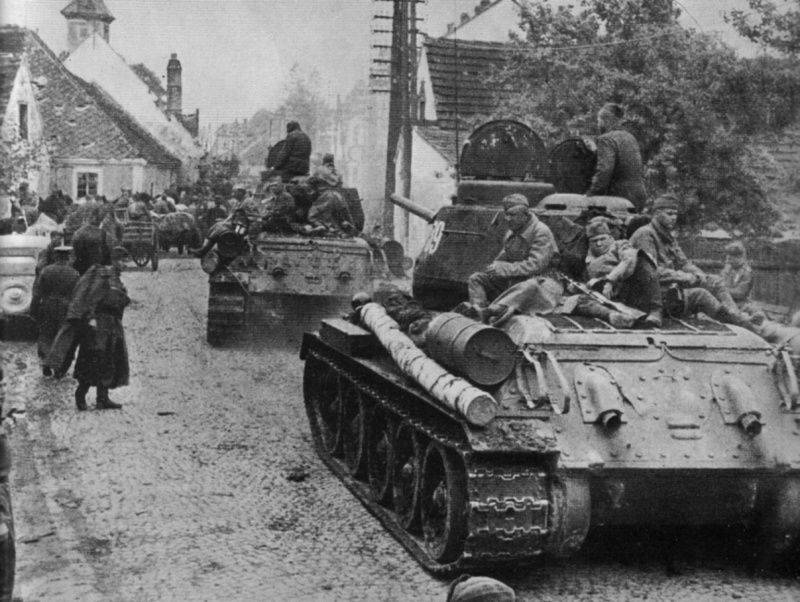
Column of Soviet tanks T-34-85 on the street of the Austrian town of St. Pölten
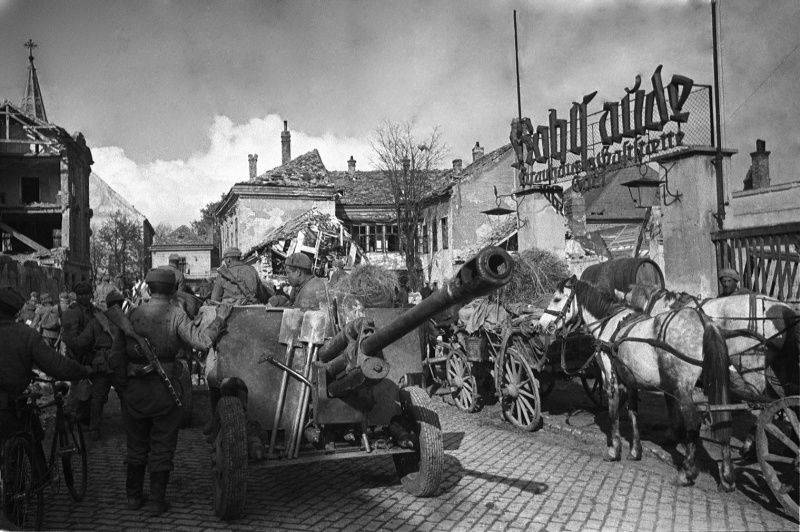
Soviet soldiers in Vienna
Results of the operation
The Vienna operation ended with the complete victory of the Red Army. The troops of 2 and 3 of the Ukrainian fronts broke through the powerful defenses of the enemy in the area between the River Hron and Lake Balaton, and defeated Army Group South in a major defeat, defeating the enemy's 32 divisions. The Red Army completed the liberation of Hungary, occupied the eastern regions of Austria with its capital Vienna. Germany lost its last ally, Hungary. The Hungarian army was almost completely destroyed or captured. The Third Reich lost the last oil-producing areas in Western Hungary (Nagykanizsa) and Austria. Germany lost an important Vienna industrial region. Berlin's hope for a “fortress in the south” collapsed. Attempts by the Germans to organize long-term resistance in Austria failed. During the offensive, Soviet troops liberated hundreds of settlements, including major Hungarian and Austrian cities.
In late April, the statehood of Austria was restored. On April 27, the Provisional Government was formed, which on the same day published a solemn declaration on the restoration of the independence of Austria. Thanks to the Soviet Union, the Austrian sovereignty of Austria, destroyed by Hitler in 1938, was restored.
In the course of the Vienna and Bratislava-Brno operations, the troops of the 2 and 3 of the Ukrainian fronts actually overwhelmed the southern strategic flank of the German front. On April 30, the defeated Army Group South was transformed into Army Group Austria, but this could not change anything. Conditions were created for an attack on Prague. With the defeat of the Wehrmacht in Hungary and Austria, the German groups in Yugoslavia and Northern Italy found themselves in an extremely difficult situation. Many of their lines of communication and communication were intercepted. The Germans began to leave Yugoslavia. The Yugoslav army was able to complete the liberation of their country. The position of the Allies in Northern Italy was alleviated.
The Red Army lost about 168 thousand people in this operation, of which irretrievable losses are more than 38 thousand people. The loss of the Bulgarian army - about 10 thousand people, irrevocable about 2,7 thousand people. There is no exact data on German losses. However, only prisoners of troops 3 th Ukrainian and 2 th Ukrainian fronts took over 130 thousand soldiers and officers of the enemy.
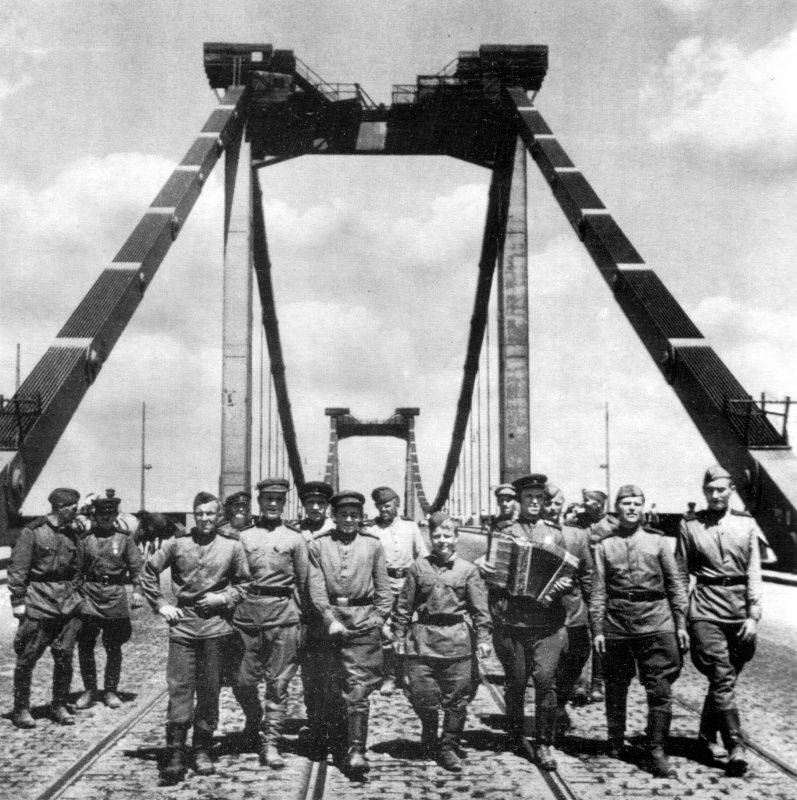
Soviet soldiers crossing the bridge over the Danube Canal in Vienna
Sources:
Ivanov, S. For the liberation of Hungary and Austria. Collection of "9 May 1945 of the Year." Memories // http://militera.lib.ru/memo/russian/9may/index.html.
History Great Patriotic War of the Soviet Union 1941-1945 (in 6 volumes). M., 1960-1965 // http://militera.lib.ru/h/6/index.html.
Malakhov M. Liberation of Hungary and Eastern Austria. M., 1965.
1944-1945. Liberation of South-Eastern and Central Europe by the troops of the 2 and 3 of the Ukrainian fronts // http://www.warmech.ru/easteur_0/europ00.html.
Sverdlov A.V. The embodiment of the plan. M., 1987 // http://militera.lib.ru/memo/russian/sverdlov_av/index.html.
Shirokorad A. B. Campaign to Vienna. M., 2005.
http://waralbum.ru/
Information